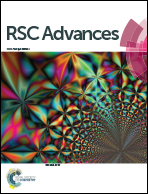An airflow-controlled solvent evaporation route to hollow microspheres and colloidosomes†
Abstract
A facile and large-scale method combining airflow-controlled solvent evaporation and amphiphilic copolymer self-assembly has been developed for the generation of hollow polymer microspheres, colloidosomes or even organic–inorganic hybrid colloidosomes. By replacing traditional agitation with the controllable airflow, this surfactant free route showed promising prospect in the fabrication of microcapsules with closed pore morphology. While the hollow polymer microspheres had an adjustable pore structure, the polymer colloidosomes and the hybrid colloidosomes possessed seamless surfaces, making them suitable for the stable encapsulation of small molecules. The hybrid colloidosomes constructed from polymer and Fe3O4 nanoparticles, and the ternary hybrid colloidosomes derived from polymer, polymer nanospheres and Fe3O4 nanoparticles displayed superparamagnetic properties and were excellent contrast agents for magnetic resonance imaging. More importantly, both hybrid colloidosomes and ternary hybrid colloidosomes exhibited a significant evolution of pore morphology from a closed pore structure to an open pore structure in response to the temperature variation, which induced a controllable release of guest molecules.


 Please wait while we load your content...
Please wait while we load your content...